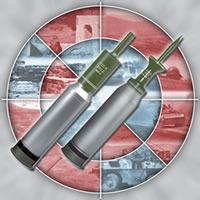PELE and ALP technologies significantly enhance the effectiveness and versatility of existing tube-fired ammunition (tank projectiles, artillery shells and rockets).
Penetrator with Enhanced Lateral Effect (PELE)
 PELE technology makes it possible to produce fully inert projectiles. The new technology modifies the projectile performance characteristics, significantly enhancing the accuracy of tank and artillery fire, while substantially reducing the risk of collateral damage. Non-explosive PELE ammunition consists of a high-density casing containing a core made of low-density, low-compressibility material. Upon impact with the target, the low-density material inside the shell is compressed to such an extent that the casing bursts, generating numerous fragments that are propelled in the direction of fire. This way, the round’s lethal impact is restricted to a defined space or limited area, reducing the likelihood of collateral damage. PELE and ALP make it possible to manufacture warheads containing little or no explosive. Moreover, existing ammunition can be inexpensively retrofitted with PELE and ALP technology. Both technologies can be integrated in full- and sub-caliber rounds, and fired from current and future weapon systems.
PELE technology makes it possible to produce fully inert projectiles. The new technology modifies the projectile performance characteristics, significantly enhancing the accuracy of tank and artillery fire, while substantially reducing the risk of collateral damage. Non-explosive PELE ammunition consists of a high-density casing containing a core made of low-density, low-compressibility material. Upon impact with the target, the low-density material inside the shell is compressed to such an extent that the casing bursts, generating numerous fragments that are propelled in the direction of fire. This way, the round’s lethal impact is restricted to a defined space or limited area, reducing the likelihood of collateral damage. PELE and ALP make it possible to manufacture warheads containing little or no explosive. Moreover, existing ammunition can be inexpensively retrofitted with PELE and ALP technology. Both technologies can be integrated in full- and sub-caliber rounds, and fired from current and future weapon systems.
In August 2006 Rheinmetall Defense acquired the industrial property and trademark rights of PELE and ALP. According to Rheinmetall, the company plans to market them in conjunction with ammunition procurement and upgrade programs both at home and abroad. Concurrently, negotiations are underway with Diehl BGT Defence GmbH & Co. KG of Überlingen, Germany to acquire licenses in various special caliber segments.
In November 2006 Rheinmetall announced the first order from Denmark, for DM-53 and upgrading of DM-33 120mm KE rounds, fielding the PELE technology.
Active Lateral Penetrator (ALP)
The Active Lateral Penetrator takes the PELE principle a step further: ALP technology can be used to create a highly effective inert penetrator or a delayed-action shell containing small amounts of explosive; the ratio between penetrating power and lateral impact can be adjusted in the process. With an Active Lateral Penetrator, the projectile’s final ballistic impact in and on the target is attained with a small amount of explosive that can be activated irrespective of the charge’s position. This creates a pressure field which is transmitted via an inert conducting medium (e.g. liquid, plastic or metal) to the surrounding shell casing, causing it to burst into fragments or release a swarm of sub-projectiles.
















